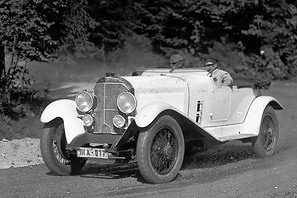In May 1926, Daimler-Motoren-Gesellschaft (DMG), which had already been associated with its former competitor Benz & Cie. in an interest group for almost two years, delivered the first examples of its new top model. The Model K was designed for drivers who were not simply looking for a touring car with very high performance and speed, but who also wanted to compete with it in motor racing with good chances.
The technical basis was the Mercedes 24/100/140 PS, a top-of-the-range touring car introduced in 1924, which could be supplied with a variety of different bodies ranging from the open touring car body and a Pullman and Landaulet version to the Coupé and Cabriolet. Despite a vehicle weight that was always well over two tonnes, the car had a thoroughly sporty character due to its 6.2-litre six-cylinder engine, which provided up to 140 hp/103 kW when the compressor was switched on. Rudolf Caracciola, for example, impressively demonstrated this when he won the touring car class in such a car in the Klausen Hillclimb in Switzerland at the end of August 1925.
In order to be able to compete in races with an even greater chance of success, the new Model K had a wheelbase that had been reduced by 350 mm; the pressed steel frame had been shortened by this amount behind the second cross-brace. The intended side effect of this measure was a reduction of the frame weight by 50 kilograms. Thus the Model K - "K" here, as with the later SSK, stood for 'kurz" (short) and not for "Kompressor" (compressor) - represented a sports car that was much easier to handle than the regular Mercedes 24/100/140 PS, even though the vehicle weight was still well over 2000 kilograms.
The engine of the shorter sports model was modified only in certain details: the 6.2-litre six-cylinder engine, like the base model, had an engine block made of the innovative aluminium alloy silumin and an overhead camshaft driven by a vertical shaft. As before, charging was provided by a Roots blower that could be switched on by the driver. To improve the cooling performance under heavy load, the number of fan blades on the radiator had been increased from four to six. The most important improvement concerned the dual ignition system, with which only the Model K was equipped. This was a combination of battery and magneto ignition systems, with each supplying one of the two spark plugs per cylinder.
The original maximum output of the super-long-stroke engine of 140 hp/103 kW at 3000 rpm with compressor was probably already increased to 160 hp/118 kW at 3100 rpm for its first sporting appearance in the Spanish Grand Prix for Touring Cars, which took place on 22 July 1926 near San Sebastian in the form of a 12-hour race. The increase in power was achieved by means of a larger compressor and a compression ratio that had been increased from 4.7:1 to 5:1.
The terrific triple success in San Sebastian, in which the driver teams Otto Merz/Walter Gärtner, Rudolf Caracciola/Heinrich Kühnle and Christian Werner/Willy Walb shared the places on the podium, was only the prelude to a multitude of victories and top placings for the new racing touring car in international motor racing. With the introduction of the far more powerful models of the new Mercedes-Benz S series, which wrote their own fascinating success story, it was only private drivers who brought the Model K to the starting line from 1927 onwards. Nevertheless, the list of successes they achieved with the high-performance vehicle extended into the 1929 season.


